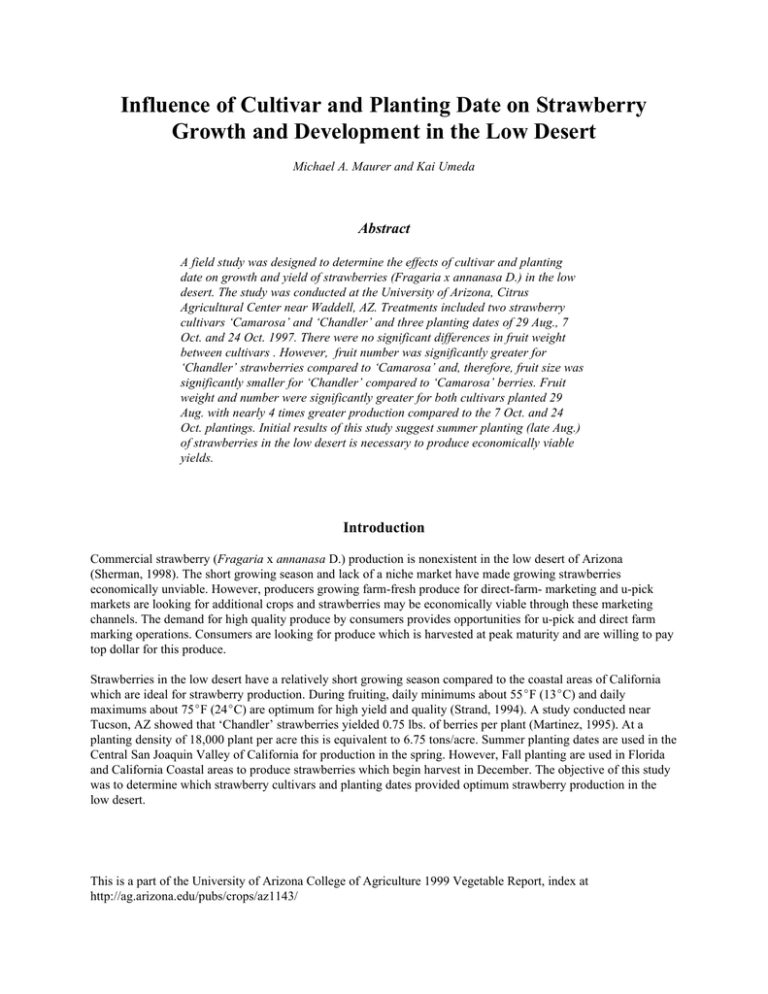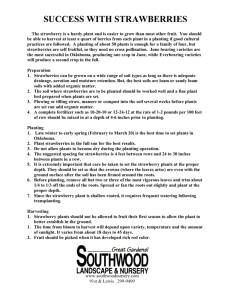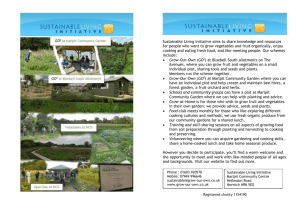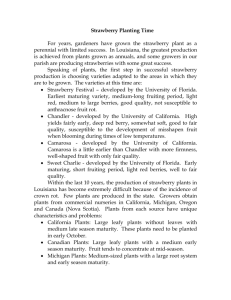Influence of Cultivar and Planting Date on Strawberry Abstract
advertisement

Influence of Cultivar and Planting Date on Strawberry Growth and Development in the Low Desert Michael A. Maurer and Kai Umeda Abstract A field study was designed to determine the effects of cultivar and planting date on growth and yield of strawberries (Fragaria x annanasa D.) in the low desert. The study was conducted at the University of Arizona, Citrus Agricultural Center near Waddell, AZ. Treatments included two strawberry cultivars ‘Camarosa’ and ‘Chandler’ and three planting dates of 29 Aug., 7 Oct. and 24 Oct. 1997. There were no significant differences in fruit weight between cultivars . However, fruit number was significantly greater for ‘Chandler’ strawberries compared to ‘Camarosa’ and, therefore, fruit size was significantly smaller for ‘Chandler’ compared to ‘Camarosa’ berries. Fruit weight and number were significantly greater for both cultivars planted 29 Aug. with nearly 4 times greater production compared to the 7 Oct. and 24 Oct. plantings. Initial results of this study suggest summer planting (late Aug.) of strawberries in the low desert is necessary to produce economically viable yields. Introduction Commercial strawberry (Fragaria x annanasa D.) production is nonexistent in the low desert of Arizona (Sherman, 1998). The short growing season and lack of a niche market have made growing strawberries economically unviable. However, producers growing farm-fresh produce for direct-farm- marketing and u-pick markets are looking for additional crops and strawberries may be economically viable through these marketing channels. The demand for high quality produce by consumers provides opportunities for u-pick and direct farm marking operations. Consumers are looking for produce which is harvested at peak maturity and are willing to pay top dollar for this produce. Strawberries in the low desert have a relatively short growing season compared to the coastal areas of California which are ideal for strawberry production. During fruiting, daily minimums about 55EF (13EC) and daily maximums about 75EF (24EC) are optimum for high yield and quality (Strand, 1994). A study conducted near Tucson, AZ showed that ‘Chandler’ strawberries yielded 0.75 lbs. of berries per plant (Martinez, 1995). At a planting density of 18,000 plant per acre this is equivalent to 6.75 tons/acre. Summer planting dates are used in the Central San Joaquin Valley of California for production in the spring. However, Fall planting are used in Florida and California Coastal areas to produce strawberries which begin harvest in December. The objective of this study was to determine which strawberry cultivars and planting dates provided optimum strawberry production in the low desert. This is a part of the University of Arizona College of Agriculture 1999 Vegetable Report, index at http://ag.arizona.edu/pubs/crops/az1143/ Materials & Methods A field study was initiated in the Fall of 1997 at the University of Arizona, Citrus Agricultural Center, near Waddell AZ. Bare-root ‘Camarosa’ and ‘Chandler’ strawberry plants were obtained from Lassen Canyon Nursery (Redding CA). These two cultivars were selected because they are the two most planted cultivars in California. Plants were established on 24 inch double row beds with subsurface drip irrigation (approximately 6 inches deep). Plants were offset 10 inches between rows and 12 inches within rows with 100 plants per plot. Both cultivars were planted on each of three planting dates 29 Aug., 7 Oct. and 24 Oct. 1997. Irrigation was applied twice daily through initial stand establishment and then as necessary to maintain soil moisture levels above 30 cbar. Nitrogen fertilization was applied as urea-ammonium nitrate solution at a rate of 2.5 lbs. N/acre weekly during stand establishment and then 5 lbs. N/acre weekly thereafter. Following the first season runners were removed between beds, but not between plants on the double row beds. Fruit weight and number were collected for each picking in 1998. Harvest began on 13 Mar. 1998 and was completed 29 May 1998. Fruit weight and number were averaged for 100 plants per plot. In 1999, harvest began on 29 Mar. 1999 and was completed 11 May 1999. Fruit weight was collected for each plot, but data represents the fruit harvested from 50 ft. of double row bed since additional runners had increased the plant density. Fruit were harvested either 2 or 3 times per week in 1998 and 99. The experimental design was a 2 (cultivars) x 3 (planting dates) factorial with 4 replicates per treatment in a randomized block design. The SAS general linear model (GLM) procedure was used to perform analysis of variance (ANOVA) and mean separation by protected least significant difference (LSD) at P# 0.05. Results & Discussion In 1998, fruit weight was significantly greater for strawberries planted 29 Aug. 1997 compared to strawberries planted 7 Oct. and 24 Oct. 1997. However, there were no significantly differences between cultivars (Table 1). In the second growing season, 1999, there were no differences between any of the treatments. The difference between fruit weight for the 1998 and 99 season can be attributed to the lower than normal spring temperatures in 1998 that extended into early summer which provided a longer growing season for the 29 Aug. planting date. The lower fruit number for the 8 and 24 Oct. planting dates in 1998 are attributed to plant size which was smaller than the 29 Aug. planting date plants. Similar to fruit weight, fruit number was significantly greater for strawberries planted 29 Aug. compared to those planted 7 Oct. and 24 Oct. Similar responses to strawberry planting dates have been observed in Arkansas (Patterson, 1995). In contrast to fruit weight, fruit number had a significant cultivar response with ‘Chandler’ producing more berries than ‘Camarosa’ (Table 1). Fruit size was not effected by planting date. However, the ‘Camarosa’ strawberries were significantly larger than ‘Chandler’ regardless of planting date (Table 1). This was the case for most of the individual harvest throughout the season (Figure 1). In addition to the larger size of the ‘Camarosa’ berries, the berries were firmer and not as susceptible to bruising as the ‘Chandler’ berries. However, the ‘Chandler’ berries tend to be a bit sweeter than the ‘Camarosa’ when fully ripe. Although, the strawberries planted on 29 Aug. 1997 had nearly 4 times greater yield than those planted 7Oct. and 24 Oct. 1997, the plants did not come into bearing as early. The first harvest for the 29 Aug. planting date was 30 Mar. 1998 (Figure 2). This may be attributed to the plants of the 29 Aug. planting date being larger than the 7 Oct. and 24 Oct. 1997 planting dates. In a near by study, initial findings indicate that the use of flowable row covers over the winter months may initiate production 3 to 4 week earlier than uncovered strawberry plants. General observations between the 1998 and 99 seasons indicate a decline in fruit quality in the second growing season. Although, overall yield was not substantially reduced in 1999 compared to 1998, there were reductions in fruit size and quality. This could be attributed to the higher plant density in 1999 due to the set of runners within the double row beds. Previous research has shown that increased plant density decreases fruit size (Goulart and Funt, 1986). Total soluble solids (sugar content) appeared to be reduced in the second year. A single sampling of second year berries averaged 7% total soluble solids measured with a hand held refractometer while a nearby field of newly planted berries averaged 10% total soluble solid. Similarly a producer indicated a similar reduction in fruit size and sweetness for strawberries grown the second season (Duncan personnel communication). In addition, the cull rate was higher in 1999 as compared to 1998 even though total yield was similar resulting in fewer marketable berries. Based on the initial results of this study the following recommendations are provided for producing strawberries in the low desert. First, summer planting (end of Aug.) is essential to achieve optimum production for either ‘Camarosa’ or ‘Chandler’ strawberries. Secondly, ‘Camarosa’ and ‘Chandler’ cultivars produce similar yields, but difference in fruit size and quality may need to be considered. Finally, strawberries should be grown as an annual crop similar to California. Even though the strawberry plants survived the summer in excellent condition , the cost associated with controlling runners, additional irrigation and reduction in fruit quality do not economically justify the second season. It appears that strawberries may have a niche for u-pick and direct farm market producers in the low desert Literature Cited Goulart, B.L. and R.C. Funt. 1986. Influence of raised beds and plant spacing on growth and yield of strawberry. J.Amer. Soc. Hort. Sci. 111(2):176-181. Martinez, L. 1995. Water use, yield, and crops coefficients for strawberries (Fragaria x annanasa D.) Ph.D. Diss., Department of Agricultural and Biosystems Engineering, The Univ. of Arizona., Tucson. Patterson, W.K. 1995. Influence of Planting date on ‘Chandler’ strawberry fields. HortScience 30(3):436. (Abstr.) Sherman, W. 1998. Arizona Agricultural Statistics. Arizona Agricultural Statistics Service. Bull. S-33. Strand, L.L. 1994. Integrated pest management for strawberries. University of California, Division of Agriculture and Natural Resources. Pub. 3351. Table 1. Influence of cultivar and planting date on fruit weight , fruit number and fruit size of strawberries in 1998 and 1999. Cultivar Planting Date 1998 1999 Fruit weight Fruit number Fruit size Fruit weight (g/100 plants) (no./100 plants (g) (g/50 ft. bed) Camarosa Aug. 29, 1997 54536 4903 11.1 30930 Chandler Aug. 29, 1997 58797 5943 10.0 41143 Camarosa Oct. 7, 1997 16074 1393 11.6 44079 Chandler Oct. 7, 1997 16463 1403 11.8 38963 Camarosa Oct. 24, 1997 16496 1334 12.2 33188 Chandler Oct. 24, 1997 14779 1479 10.0 49399 Cultivar NS * * NS Planting Date *** *** NS NS Interaction NS NS NS , *,**,*** Not significant or significant at P # 0.05, 0.01 and 0.001, respectively. NS Significance NS Figure 1. Effect of planting date on fruit weight of strawberries from individual harvest throughout the harvest season, 1998. Figure 2. Effect of cultivar on fruit size of strawberries from individual harvest throughout the harvest season, 1998.






